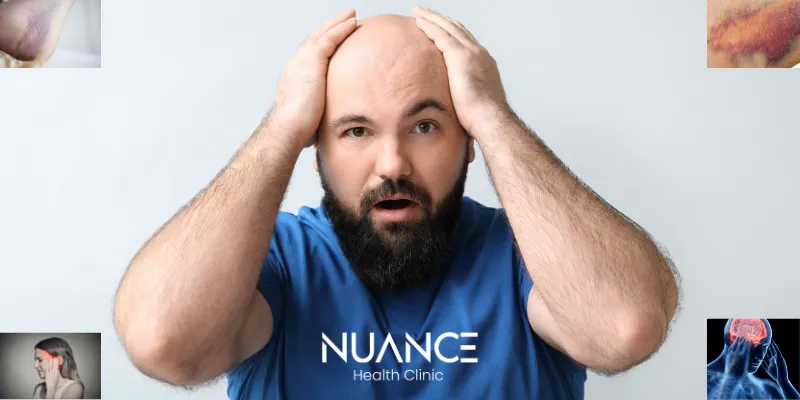What are side effects of hair transplant?
What are side effects of hair transplant?
Although deciding to get a transplant to get a bigger head of hair is an exciting choice, it's important to know what side effects might happen. The majority of hair transplant treatments are safe, but some people may feel some minor pain. Inflammation, bruises, and slight pain at the donor site are all common side effects. As a reminder, these effects usually go away in a few days to weeks. By knowing these possible results, people can make better choices, and their recovery will go more smoothly.

-
Common side effects
Hair transplants often cause temporary swelling, bruising, and mild pain at the spot of the graft. Your body is adjusting, so these responses are normal. Do not worry; these effects usually only last a few days to a few weeks. Small bumps may show up on your way to longer hair, but that's just how the healing process works.
-
Long-term side effects
Long-term side effects from a hair transplant are very uncommon, which should reassure people who are thinking about getting one. Possible side effects include minor scars or changes in how the skin feels in very rare cases. Now that methods have improved, these effects are much less likely to happen, so the long-term result is usually safe and successful.
-
Infection risks
It is still important to know about infections, even though they are not likely to happen. Post-transplant hair loss, some people get infections at the site of the graft. Sticking to the post-surgery care directions, which include keeping the area clean, lowers this chance. Recovering safely and effectively depends on quickly talking about any worries with your surgeon.
-
Scarring
Hair transplants usually leave small, unnoticeable scars. Using modern methods, scars are kept to a minimum to maintain a natural look. Although you may have some small scars, they are generally very hard to see because they are in your hair. Speaking to your surgeon about your worries about scarring before the treatment helps you set realistic goals and ensures a good result.
-
Bleeding and bruising
Some bleeding and bruises may happen during a hair transplant. It's normal and expected for this to happen because small blood vessels are involved. In a short time, the body heals itself from these small effects. Following post-operative care instructions, like staying away from strenuous activities, can help reduce these brief issues, making healing go more smoothly.
-
Allergic reactions
Allergic reactions during a hair transplant are highly unlikely. Before the surgery, your medical team will get a sense of any possible drug issues. Thorough pre-screening lowers the chance of allergic reactions. Feel safe knowing that your well-being is our main concern during the hair regrowth process.
-
Nerve damage
During a hair transplant, nerve damage is very rare. During surgery, surgeons are very careful not to hurt nerves. The process only touches the top layers of the head, which lowers the risk. Understanding how rare this is can help ease your worries, and talking about your fears with your surgeon ahead of time will make sure that your hair restoration trip is safe and well-informed.
-
Unnatural-looking results
With today's methods, hair transplants rarely give results that don't look natural. Skilled surgeons focus on making the hairline and thickening look natural. Before surgery, it can help to talk about your goals in more depth. This will help you be satisfied with the outcome. You must have a lot of faith in your medical team in order to get a result that looks natural.
-
Psychological impact
Being more confident and having higher self-esteem can be good for your mental health after getting a hair transplant. Just remember to keep your goals in check. Going through a smooth shift is guaranteed if you talk to your surgeon ahead of time about your worries and goals. Being aware of the mental advantages makes it possible to have a more satisfying and assured experience following a transplant.
What are the disadvantages of hair transplant?
Small risks, like swelling, bruises, and brief pain, can happen after a hair transplant, but the procedure is usually safe. Things like scarring or allergy responses may happen very rarely. Making sure you have a full conversation with your surgeon about possible risks will help you set realistic goals for a successful and satisfying hair transplant journey.
Can hair transplant fail?
No, hair transplant cannot fail. Which person is chosen, how skilled the surgeon is, and the care given after surgery all affect how things turn out. If you have detailed talks, set realistic goals, and follow the aftercare instructions, your hair transplant is much more likely to work and be worth it.
Do hair transplants leave scars?
Yes, hair transplants may leave small scars that are hard to see. Modern methods try to hide scars by hiding them in hair so that they look natural. There are small marks, but they are usually hard to see. Talking to your surgeon about your worries ahead of time can help you manage your hopes and make sure you get a good result with a few scars that you can see.
Do people regret hair transplants?
No, people do not regret hair transplant. Improving confidence and happiness are feelings that most people have. Realistic goals are very important, though. Talking to your surgeon about your goals and possible outcomes guarantees positive results. Comprehensive talks lower the risk of regret, leading to more educated and happy outcomes after transplant.
Do hair transplants look bad at first?
Yes, there is sometimes temporary redness, swelling, or scabbing after a hair transplant. These feelings are normal and necessary for healing. Long-term, the transferred hair will settle down, and any initial flaws will go away, leaving a natural and pleasing result. Staying patient during the healing process will get you the best results.
Are there any long-term effects of hair transplant?
No, the long-term effects of a hair transplant are usually good, and the results look realistic. While extremely rare, there might be minimal scarring or changes in skin sensation. Advances in techniques minimise these risks. Thorough pre-operative discussions and follow-up care ensure a safe and satisfying long-term outcome for individuals considering hair restoration.
What happens 10 years after hair transplant?
People often have a lasting increase in hair density that looks normal ten years after getting a hair transplant. Modern methods lessen the effects that last a long time. Follow-up visits with your surgeon and following through with post-surgery care are important for a happy and long-lasting result that gives you more confidence and hair.
Is Turkish hair transplant painful?
No, Turkish hair transplant isn’t painful. Slight distress is avoided by employing local anaesthesia throughout the procedure. Following the procedure, patients might encounter transient, moderate discomfort or tenderness. For a successful hair restoration voyage, surgeons place a high value on patient comfort, striving to ensure as painless an experience as possible.
How long do hair transplants last?
Most hair transplants are permanent. The transferred hair looks and acts like real hair and will last forever. Modern methods make sure that the results look realistic and last for a long time. If someone wants to get a hair transplant, they need to make sure they pick a skilled surgeon and carefully follow the home care guidelines.
Is hair transplant safe in Turkey?
Yes, hair transplants in Turkey are safe. People know the country for its excellent doctors and up-to-date hospitals. But it's very important to do your research and pick a clinic with skilled staff that has a good reputation. Making sure the centre follows the right safety rules will increase the chances of a good and safe hair transplant in Turkey.

